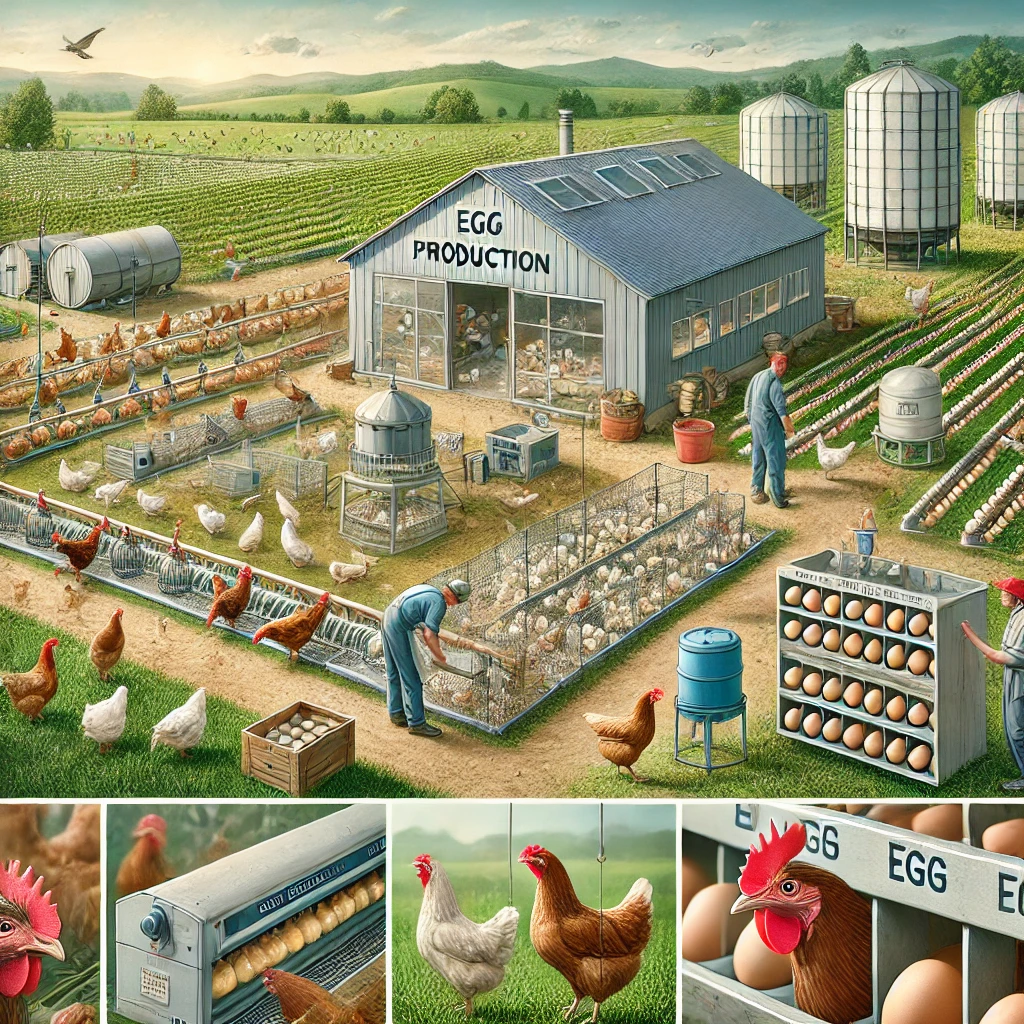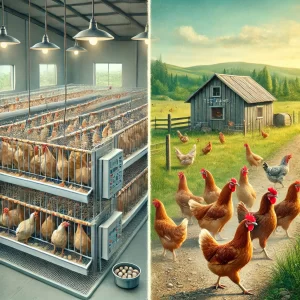
Discover effective strategies for enhancing the production of eggs in your homestead setup. From breed selection to feeding practices, this guide covers all you need to know.
Comprehensive Guide to Egg Production for Sustainable Living Enthusiasts
1. Introduction to Egg Production
Definition of Egg Production: Understanding Oviposition in Poultry
Production of eggs, or oviposition, refers to the process by which hens produce eggs. This process is a key aspect of poultry farming, with various factors influencing the quality and quantity of eggs produced. Understanding the intricacies of egg production is crucial for ensuring high-quality output, whether for commercial purposes or small-scale, sustainable farming.
Importance of Data-driven Insights in the Egg Industry
In the egg industry, data-driven insights are essential for optimizing production, improving egg quality, and ensuring the welfare of laying hens. Analyzing factors such as feed composition, environmental conditions, and production systems allows farmers to make informed decisions that enhance productivity and sustainability. With the growing demand for organic and ethically sourced eggs, leveraging data can help producers meet market needs efficiently.
2. Overview of the Production of Egg Process

Stages of Egg Production: From Breeding to Market
The egg production process begins with selecting high-performing breeds known for their egg-laying capabilities. Once hens reach maturity, they are housed in systems designed to support optimal laying conditions. Eggs are collected, graded, and packaged for distribution to markets, ensuring they meet quality and safety standards.
Selection of Breeds: Characteristics and Performance Metrics
- Leghorn: Known for their prolific egg-laying, producing up to 300 eggs per year.
- Rhode Island Red: A versatile breed with high egg production and hardiness.
- Isa Brown: A hybrid breed with high egg-laying efficiency and excellent feed conversion ratios. Selecting the right breed is crucial for achieving desired production outcomes, whether focusing on quantity, egg size, or specific market preferences.
Hatchery Management: Incubation Techniques and Technologies
Effective hatchery management involves maintaining optimal incubation conditions, including temperature, humidity, and ventilation. Modern technologies such as automated incubators ensure consistent conditions, increasing hatch rates and improving the health and productivity of the hens.
3. Factors Influencing Egg Production

Environmental Factors Affecting Hen Productivity
- Temperature Control: Hens thrive in temperatures between 55°F and 75°F. Extreme temperatures can stress the birds, leading to reduced egg production and quality.
- Lighting Conditions: Light exposure plays a crucial role in stimulating egg production. A consistent light schedule of 14-16 hours per day encourages hens to lay eggs regularly.
Nutritional Requirements for Optimal Laying
- Feed Composition Analysis: A balanced diet is vital for egg production. Layers require a diet rich in protein (16-18%), calcium, and other essential nutrients. Quality feed should include grains, protein sources like soybean meal, and supplements to meet the birds’ nutritional needs.
- Role of Supplements in Enhancing Production: Calcium supplements such as oyster shells are essential for strong eggshells. Vitamins and minerals like Vitamin D, phosphorus, and selenium support overall health and productivity.
4. Types of Egg Production Systems
Conventional vs. Alternative Systems
- Conventional Systems: Involves keeping hens in cages designed to optimize space and facilitate egg collection. While efficient, there are concerns about animal welfare and natural behaviors.
- Alternative Systems:
- Cage-Free: Hens are housed in an open area with access to nesting boxes and perches, allowing more natural behavior.
- Free-Range: Hens have outdoor access, promoting a natural lifestyle and foraging.
Benefits to Animal Welfare: Cage-free and free-range systems provide hens with a more natural environment, reducing stress and promoting better health.
Impact on Egg Quality: Eggs from free-range and cage-free systems are often perceived as having higher quality, with richer yolk color and improved taste, attributed to the hens’ varied diet and healthier lifestyle.
Organic Farming Practices: Standards and Certifications
Organic production of eggs adheres to strict guidelines, including organic feed, no synthetic additives, and access to outdoor spaces. Certification by entities like the USDA ensures that organic eggs meet established standards, appealing to consumers seeking sustainable and ethically produced products.
5. Quality Control in Egg Production

Assessing Eggs: Quality Grading Criteria
- Shell Integrity Testing: Ensures the eggshell is free from cracks and defects, reducing the risk of contamination.
- Internal Quality Evaluation: Includes assessing the yolk color, albumen height, and overall freshness. Higher yolk color intensity and firm albumen indicate a high-quality egg.
Implementing Best Practices for Hygiene and Safety
Maintaining cleanliness in the coop, regular health checks, and following proper egg handling protocols reduce the risk of contamination and ensure eggs meet safety standards.
6. Economic Aspects of Commercial Egg Production
Cost Analysis: Investment vs. Return on Investment (ROI)
- Initial Setup Costs: Include building or purchasing coops, incubators, and feeders, as well as buying chicks or pullets.
- Operational Expenses Breakdown: Covers feed, utilities, labor, and veterinary care. Feed costs are the most significant expense, representing around 60-70% of total production costs.
Market Trends: Demand Forecasting and Pricing Strategies
With increasing demand for organic and cage-free eggs, producers can command premium prices. Staying informed about consumer preferences and market trends allows farmers to adjust production strategies and pricing to maximize ROI.
7. Sustainability in Production of Eggs

Sustainable Practices Overview
- Waste Management Solutions: Composting manure and using it as fertilizer reduces waste and enhances soil fertility.
- Water Conservation Techniques: Implementing efficient water systems and using water-saving devices in coops help reduce water usage and promote sustainability.
Case Studies on Successful Sustainable Farms
Farms implementing sustainable practices, such as rotational grazing and solar-powered coops, demonstrate improved hen welfare, reduced environmental impact, and higher-quality eggs. These practices often lead to greater consumer trust and loyalty.
8. Challenges Facing the Industry
Disease Management Strategies
- Common Diseases Affecting Layers: Include Salmonella, Avian Influenza, and Marek’s Disease. Regular monitoring, biosecurity measures, and vaccinations are essential for preventing outbreaks.
- Biosecurity Measures: Implementing strict biosecurity protocols, such as controlling access to the farm and regular sanitation, helps prevent disease introduction and spread.
Regulatory Compliance Issues
- USDA Regulations: The USDA sets standards for egg safety, labeling, and quality, including guidelines for organic certification.
- Labeling Requirements: Labels like “cage-free,” “free-range,” and “organic” must meet specific criteria set by regulatory bodies to ensure accurate representation and consumer trust.
9. Technological Innovations Shaping the Future

Technology Adoption in Poultry Farming
- Smart Farming Solutions: Use of sensors and IoT devices for monitoring environmental conditions, production of egg rates, and hen health, enabling real-time data analysis and decision-making.
- Data Analytics Applications: Data analytics tools help optimize feed efficiency, predict egg production patterns, and improve overall farm management.
Automation Impact on Efficiency
- Egg Collection Systems: Automated egg collection reduces labor costs and minimizes the risk of damage during handling.
- Feed Distribution Technology: Automated feeders ensure consistent and precise feed delivery, improving feed efficiency and reducing waste.
10. Conclusion
Summary of Key Findings
Egg production is a multifaceted process influenced by breed selection, nutrition, environmental factors, and production systems. Sustainable practices and technological advancements are driving improvements in efficiency, egg quality, and hen welfare.
Future Outlook for the U.S. Egg Industry
The industry is expected to continue evolving towards more sustainable and humane practices, with increasing consumer demand for organic and cage-free eggs. Technological innovations will further enhance production efficiency and environmental sustainability.
11. Appendices
Additional Resources
- USDA guidelines on egg production and handling
- American Egg Board resources on egg quality and nutrition
Relevant Research Studies
- Studies on the impact of housing systems on egg quality
- Research on the nutritional benefits of organic vs. conventional eggs
Contact Information for Professional Services
- Veterinary services specializing in poultry health
- Agricultural consulting services for production of egg optimization
12. References
Cited Works
- USDA (United States Department of Agriculture). Egg Production and Safety Guidelines.
- American Egg Board. Egg Quality Standards and Nutritional Benefits.
Additional Reading Materials
- Publications on sustainable production of eggs practices
- Articles on technological advancements in poultry farming
Reference and Resources
USDA (United States Department of Agriculture)
- Overview: The USDA provides extensive resources on the production of eggs, including guidelines for animal welfare, food safety, and organic certification. They play a crucial role in setting standards and ensuring compliance within the industry.
- Key Resources and Services:
- Egg Safety and Quality Guidelines: The USDA offers detailed guidelines on proper egg handling, storage, and quality control to prevent contamination and ensure consumer safety.
- Organic Certification: Provides information and support for farmers seeking organic certification for their production of eggsP, ensuring adherence to standards regarding feed, housing, and animal welfare.
- Research and Data: Access to research on best practices in the production of eggs, including nutrition, disease prevention, and sustainable farming techniques.
- Contact Information:
- Website: USDA Official Website
- Egg Safety Resources: USDA Egg Safety
- Hotline: 1-888-674-6854 (USDA Meat and Poultry Hotline for egg safety inquiries)
American Egg Board
- Overview: The American Egg Board (AEB) is the egg industry’s national marketing organization, providing resources on egg nutrition, quality, and culinary uses. The AEB supports both producers and consumers with information on best practices and industry standards.
- Key Resources and Services:
- Egg Nutrition and Quality Information: Offers educational materials on the nutritional benefits of eggs and how to evaluate egg quality, including the Egg Nutrition Center’s research and resources.
- Marketing and Promotion: Provides marketing support and promotional materials for egg producers to enhance consumer awareness and demand for eggs.
- Research and Innovation: The AEB funds research on egg production, quality, and nutrition to support industry advancement and inform best practices.
- Contact Information:
- Website: American Egg Board
- Egg Nutrition Center: Egg Nutrition Center
- Email: info@aeb.org (for general inquiries)
These organizations provide valuable resources and support for egg producers, from ensuring compliance with regulations to promoting best practices in sustainable and ethical egg production. Utilizing these resources can help farmers improve their operations, meet consumer demand, and contribute to a more sustainable and responsible egg industry.


